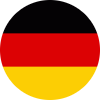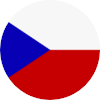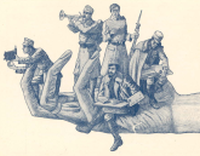Muses to the front!
Writers and Artists Working for Austro-Hungarian War Propaganda
„Inter arma silent musae“. The famous saying about the silence of the muses during war is based on the ideal of art as a product only of the human mind, untouched by blood and violence. In reality, no battles were ever fought without writers and artists having their say about them.
The magnitude and consequences of the First World War exceeded those of all previous wars; even at the time people called it the „Great War“. The number of countries involved, the number of soldiers fighting on different fronts, the millions of victims and the extent of the destruction justify this term. Furthermore, military technology that had not been used before was used for the first time: gas, aeroplanes, armoured combat vehicles, heavy artillery, but also war propaganda as a way of influencing public opinion and thus fighting „by other means“.
For propaganda purposes a „War Press Quarter“ (KPQ) was founded as a special facility of the High Command of the Austro-Hungarian army, which provided the press with reports on the war. An particularly large number of journalists and artists joined the KPQ, including well-known writers such as Roda Roda, Egon Erwin Kisch, Leo Perutz, Richard A. Bermann (Arnold Höllriegel), Ferenc Molnár, Robert Michel, Franz Werfel or artists such as Oskar Laske, Oskar Kokoschka, Ferdinand Staeger, Ludwig Hesshaimer, Albin Egger-Lienz. Among other things a photography and film unit was set up to report on the war, as well as a theatre and music department and even a censorship unit, which monitored all information and decided what was to be published.
At the same time, a „literary group“ was created in the Vienna War Archives, which documented the war and promoted the cause of the Empire through journalism. Franz Theodor Csokor, Rudolf Hans Bartsch, Franz Karl Ginzkey, Felix Salten, Stefan Zweig, Rainer Maria Rilke, Alfred Polgar (Polak) worked in this group.
Both the KPQ and the „Literary Group“ offered many journalists, writers and artists the opportunity to avoid military service and to take on a job in making war propaganda whether with pen, brush or camera.
The exhibition and the accompanying publication show the deliberate or unconscious part literature and art played in the First World War. It describes both the wavering of artists and intellectuals between patriotism and pacifism as well as their voluntary engagement with the war. Many different attitudes towards war become apparent when comparing the different personalities, but diverse phases and changes can also be observed within individual biographies.
Some of the writers and artists serving the Austro-Hungarian war propaganda came from Bohemia and Moravia; special attention is paid to these in the exhibition.
Contact
Anna Knechtel M.A., knechtel@stifterverein.de, Phone number +49 89/62 27 16-30
Practical information
35 panels in glass frames measuring 80 x 60 cm (portrait format only)
Text
The text on the panels is in German. The text is also available in Czech, Slovenian, English, Italian and Hungarian.
Promotional material
Press releases
Accompanying publication in 2 volumes, ed. by Jozo Džambo (Part 1: Articles, Part 2: Documentation)
Terms and costs
The exhibition can be borrowed after consulting a representative of the ASV and signing an agreement on the rental of the exhibition. No fees apply. Usually, the exhibition is to be collected in Munich and returned to Munich after it has ended.
The organizer pays for transport, insurance, posters and invitations, the assembly and dismantling of the exhibition, as well as travel costs and accommodation costs for an employee of the Adalbert Stifter Association (who gives an introductory lecture). Special agreements may apply after consultation with the ASV and then form a part of the agreement on the rental of the exhibition.
Transport
The exhibition posters are framed. Sufficient upholstery material is necessary to prevent the glass from breaking: blankets, wood shavings or cardboard, cords and expandable bands for securing.
Previous locations of the exhibition
Since it was first opened on May 19, 2003 in the Alfred Kubin Gallery in the Sudeten-German-House, Munich, the exhibition has been shown in:
Linz, Prague, Brno and Slavkov (2004)
Innsbruck and Kobarid (Slovenia) (2005)
Ljubljana (Slovenia) (2006)
Budapest, Pécs (Hungary) and Székesfehérvár (Hungary) (2008)
Graz, Vienna (2009)
St. Michael/Burgenland (2010)
Kaufbeuren-Neugablonz, Jizera Mountains Museum (2012)
Plankstetten Abbey (Upper Palatinate) und Dresden (2014)
Düsseldorf, Gerhard Hauptmann House (2016)
Speinshart Monastery (2019)








